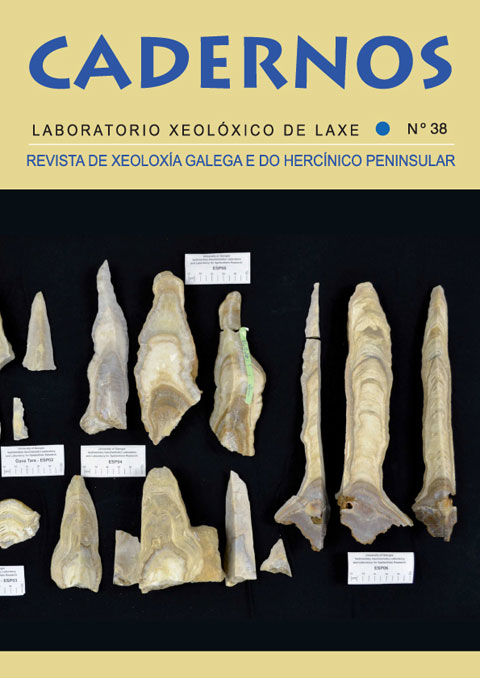Preliminary studies of the palygorskite deposit from Figueiró do Campo (Soure, Portugal)
Main Article Content
Abstract
The technical characteristics of miocenic palygorskite rich-sediments from an area near Figueiró do Campo (Soure, Portugal) are presented. The deposit is probably the most promising area in Portugal concerning palygorskite as a resource. In this first study we evaluate three samples collected in the bottom, medium and top levels of the deposit. The samples has 58-79 % in weight under 63 µ and the average particle size in the fraction < 63 µ has 0.2 to 2.2 µ in size. DRX data revealed that the fraction < 63 µ are 26-34 % quartz, 4-6 % Fe oxide and 61-70 % palygorskite. The fraction < 2 µ is 89-93 % palygorskite, 4-8 % quartz, 3-4 % Fe oxide and 0-3 % caolinite. The palygorskite fibbers were observed in MEV and average 344 nm (length) and 31 nm (thickness). From FRX analysis we obtain the following compositions: 69-60 % SiO2, 11-17 % Al2O3, 7.5-5.1% MgO and 3.6-6.6 % Fe total. CTC are in the range 7.2-11.2 meq/100g, and the pH between 6.0 and 7.1. The moisture are between 9.21 and 15.08 %. Oil and water sorption are respectively in the range 69-100 % and 75-134 %. Einlehner abrasivity is between 11 and 80 mg in the fraction < 63 µ, and 1.21.9 mg in the fraction < 2 µ. In the overall results do not exclude the possibility of a feasible exploitation. It is thus essential to proceed with a geophysical study (to determine the thickness and form of the deposit) and with boreholes exploration in order to get fresh samples from the interior of the mineralized level. The deposit was probably formed in a restricted basin filled with alkaline waters and the palygorskite precipitated from solutions satured with silica and magnesium although we cannot preclude a formation after an esmectite precursor.
Keywords:
Downloads
Article Details
References
Alves, W., 2013. Caracterização da paligorsquite de Figueiró do Campo. Tese de Mestrado. Universidade de Aveiro.
Cunha, P.P., Reis, R.P., 1989. Principais ocorrências de paligorsquite, em depósitos de idade cretácica superior e terciária, em Portugal Central. 1° Reunião Luso-Espanhola de Argilas, p. 22.
Cunha, P.P., Reis, R.P., 1992. Establishment of unconformity-bounded sequences in the Cenozoic record of the western Iberian margin and synthesis of the tectonic and sedimentary evolution in central Portugal during Neogene. Abstracts of the First Congress RCANS, Lisboa, pp. 33–35.
Dias, I., 1998. Caracterização Mineralógica e Tecnológica de Argilas Especiais de Bacias Terciárias Portuguesas. Tese de doutoramento. Faculdade de Ciências da Universidade de Lisboa.
Galán, E., Pozo, M., 2011. Palygorskite and sepiolite deposits in continental environments. Description, genetic patterns and sedimentary settings. Em Developments in Palygorskite-Sepiolite Research: A New Outlook on These Nanomaterials, E. Galán, A. Singer (editores), Elsevier. Developments of Clay Science. p. 125-166.
Galopim De Carvalho, A., 1968. Contribuição para o Conhecimento Geológico da Bacia Terciária do Tejo. Serviços Geológicos de Portugal, Memória nº15 (Nova Série), Lisboa, 210 p.
Guggenheim, S., Krekeler, M., 2011. The structure and microtextures of the palygorskite-sepiolite group minerals. Developments in palygorskite-sepiolite research. A new outlook on these nanomaterials. Editado por Galan, E. e Singer, A. (editors). Elsevier. Developments in Clay Science 3, p. 3-65.
Harben, P., 2002. The industrial minerals Handybook: A guide to markets, specifications and prices. 4th edition. Metal Bulletin plc, London.
Heivilin., H. M., 1994. Hormites: Palygorskite (Attapulgite) and Sepiolite, in Industrial minerals and rocks, Littleton, Colorado: Society for Mining, Metallurgy and Exploration. p. 249-254.
Jones, B., Conko, K., 2011. Environmental influences on the occurrences of sepiolite and palygorskite: A brief review. Em Developments in PalygorskiteSepiolite Research: A New Outlook on These Nanomaterials, E. Galán, A. Singer(editores). Elsevier. Developments of Clay Science. p. 69-81.
Luz, A., Almeida, S., 2008. ArgilaAtapulgita e Sepiolita. Em: Rochas e Minerais Industriais: Usos e Especificações. Parte 2Rochas e Minerais Industriais: Usos e Especificações. CETEM Rio de Janeiro, p. 223-238.
Miller, K., Fairbanks, R., 1983. Evidence for Oligocene-Middle Miocene abyssal circulation changes in the western North Atlantic. Nature, 306 (5940), p. 250-253.
Pais, J., Cunha, P. P., Legoinha, P., 2010. Litostratigrafia do Cenozóico de Portugal. Em Neiva, J.M. et al., (Editores). Ciências Geológicas e Investigação. V. I, 365-376.
Reis, R. P., 1983. A sedimentologia de depósitos continentais. Dois exemplos do Cretácico Superior-Miocénico de Portugal. Tese de doutoramento. Universidade de Coimbra.
Velho, J., 2005. Mineralogia Industrial. Princípios e Aplicações. Edições Lidel, Lisboa, 600 p.
Velho, J., Moura, A., Alves, W. 2014. Activação ácida em sedimentos paligorsquiticos da região de Soure. (trabalho submetido a congresso).
Weaver, C., Beck, K., 1977. Miocene of the S.E. United States: a model for chemical sedimentation in a peri-marine environment. Development in Sedimentology, 22: p. 234.







